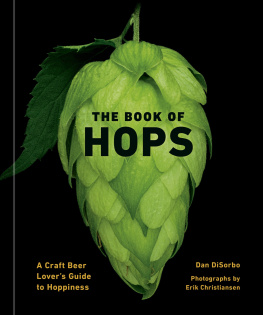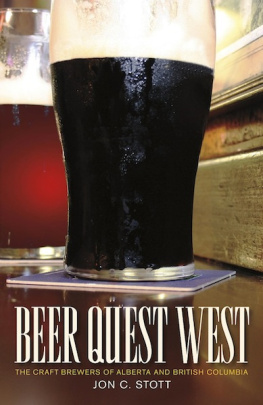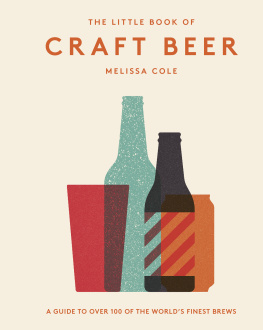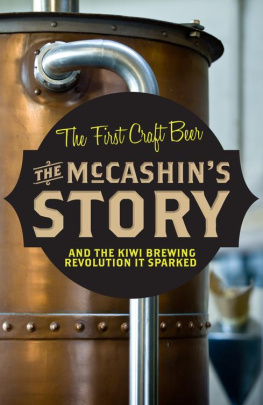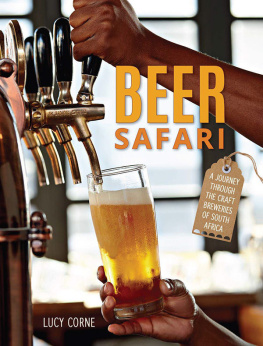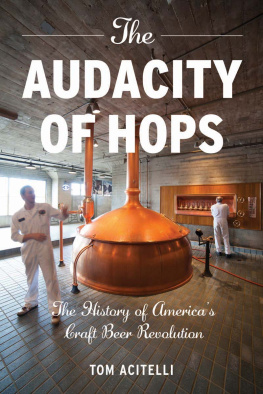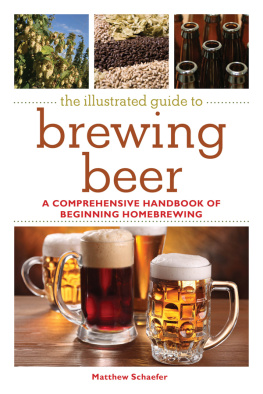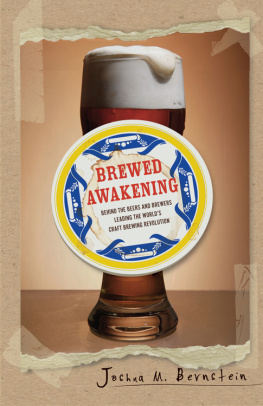Contents
Landmarks
Print Page List
DAN DISORBO is a principal at PB&J Design, an award-winning brand design agency, and author and illustrator of several bestselling books. He was also cofounder of a successful Connecticut craft brewery and has won numerous competitions in the craft beer industry.
ERIK CHRISTIANSEN is a self-taught photographer and pioneer of focus-stacked photography. His hyper-detailed macro photography has been featured on the cover of Newsweek, in Time magazine, and on Slate, NPR, and Mashable.
Craft Beer Lingo
The continued progress of craft beer culture is driven by a diverse community of industry professionals and craft beer drinkers who are often as eccentric as the special language they sometimes use. Heres a rundown of juicy terms to consider while crafting a balanced vocabulary on your path to becoming a true zythophile.
ABV: Alcohol by volume, a measure of strength; the percentage of alcohol present in a given volume of water.
acetic: Sensory descriptor implying vinegary acidity and generally considered undesirable.
adjunct: Any nonmalted source of fermentable sugars. This includes fruits, vegetables, and sugars such as honey and maple syrup, as well as unmalted grains, such as barley, wheat, oats, and rice.
aftertaste: Any lingering tastes noticeable after swallowing a sip of beer.
alcohol or Ethyl-Alcohol: The intoxicating liquid byproduct of the fermentation of sugars by yeast.
ale: A category of beer made with top-fermenting yeast at temperatures relatively warmer than its counterpart. See also Lager.
alphas: Common term used for alpha acids contained in the resin glands of hops. These are the main source of hop bitterness in finished beer.
aroma hops: A broad category of hops that contain a high level of essential oils that impart a multitude of diverse aromas and flavors to the finished beer. See also oils.
astringent: A drying, puckering mouthfeel sensation thats generally unpleasant. See also hop burn.
attenuation: The degree to which sugars are converted to alcohol and CO during fermentation. Highly attenuated beer generally has a clean, crisp mouthfeel, whereas low attenuation contributes to more body and sweetness.
balance: A harmony between contrasting elements typically used when speaking of hops and malt.
barley: By far the most common cereal grain used in beer production. See also malt.
barrel: A wooden vessel; or a measurement of liquid thirty-one gallons. A typical keg of beer is equal to half a barrel.
barrel-aging: Conditioning of beer in a wooden barrel often over a long period of time in order to mellow and absorb the characteristics of the barrel itself or of the liquid that previously was held in the barrel.
bine: A climbing plant, such as hops, that wraps itself around a support. Unlike a vine, a bine doesnt use tendrils or suckers, but instead twists itself in a helix around a rope as it grows.
bittering hop: A broad category of hops that contain high amounts of alpha acids, which are generally boiled in order to activate bitterness. See also isomerize.
bitterness: Generally refers to the hop characteristic that is sharp, astringent, and lacking any sweetness.
body: Used to describe the liquid viscosity of beer and the sensation of its fullness, thickness, or lack thereof on the palate.
bottle- or can-conditioned: Beer that is carbonated naturally by live yeast inside the bottle or can itself.
Brettanomyces or Brett: A genus of wild yeast, generally considered a spoilage organism, but it is intentionally featured in Sour and wild beer styles.
carbonation: The amount of bubbles that occur when carbon dioxide (CO) dissolves in beer. This can vary widely depending on the beer style and/or a brewers preference when they carb-up their beer.
chill haze: A hazy appearance that results after a beer is made cold.
clean beer: Broad term for the many beer styles made in sterile environments with saccharomyces yeast strains.
collab: A collaboration between two different breweries or brewers on the creation of a single beer often promoted and released collectively.
continental hops: See Old World.
coolship: A shallow, open-top vessel that exposes freshly brewed wort to the open air, both to cool this hot liquid down and to inoculate it with yeast and/or other microorganisms.
crispy: A mouthfeel associated with a high attenuation and/or high carbonation. Also, a slang term for a craft Lager beer.
crushable: Beer that is easy to drink and refreshing, usually referring to a lower ABV. See also sessionable.
DDH: Double dry-hopped.
decoction: An old-school mashing technique where a portion of the mash liquid is removed, boiled, and then returned. See also mash.
diacetyl: A buttery, undesirable off-flavor caused by incomplete fermentation/conditioning or bacterial contamination.
distro: Short for distribution; used to describe beer that is delivered and made available in bars and stores, not just the brewery. See also release.
draft (draught): Beer poured from a faucet or tap.
drain pour: A beer that is undrinkable for various reasons and discarded immediately.
dry-hopping: Adding hops during or after fermentation with the goal of infusing only the aromas and flavors associated with the essential oils, not the bittering alpha acids.
essential oils: See oils .
esters: These are flavor compounds created primarily by yeast during fermentation, where an organic acid and alcohol combine to form what are generally considered sweet, fruity flavors.
fermentation: The conversion of sugar to ethyl alcohol and carbon dioxide by yeast.
fermenter or fermentation tank: A vessel used in the brewing process to ferment beer.
FG: Short for final gravity; this is the measurement of the relative density of a beer at the end of fermentation.
filtration: The process by which particulate matter is removed from liquid via various methods and mediums to stabilize or otherwise clarify the liquid.
finishing hops: Hops that are added toward the last several minutes of the boil in the brewing process; generally aroma or dual-use varieties.
flight: A tasting sampler of a brewerys offerings, typically poured in smaller serving glasses.
flocculation: The propensity of yeast cells to aggregate after fermentation and drop out of suspension, characterized as high, low, or medium. For example, high-flocculating yeast will drop out almost completely and is less likely to be left in solution.
fresh-hop: See wet-hop .
grains: During the brewing process, grains provide the sugars that will drive the production of alcohol by yeast during fermentation. The list of grains that can be used is vast, although most beer is made from cereal grains like barley. See also malt.
green: Term generally used to describe beer that has finished primary fermentation but has yet to finish conditioning. Can also refer to a freshly packaged beer that if drunk too soon presents more vegetal and/or harsh hop flavors rather than a smoother flavor, if allowed to rest for a period.
grist: All the grains for a beer recipe that are milled and mixed together.
gruit: Popular prior to the adoption of hops, this alcoholic beverage utilized a mixture of bittering and flavoring herbs and other botanicals instead of hops to balance the sweetness of malt.
haze/hazy: The cloudy appearance of unfiltered beer. See also turbidity. Also, a slang term for New England IPA.
head: The frothy foam at the top of a poured beer.
heat: A warming mouthfeel associated with higher ABV beers.
heavy: A bold beer with higher alcohol content. Also often called high-gravity or big beer.
hop: The female cone flower of the plant species Humulus lupulus .

